What is a PVT?
A Parallel Vote Tabulation (PVT) is a proven methodology often employed by nonpartisan citizen observers to systematically assess the election day process including the counting of results at polling stations. PVT can independently verify the official results announced by the Central Election Commission (CEC). A PVT relies on reports from highly trained observers who evaluate the quality of the process at the polling station. Unlike exit polls, PVTs do not ask people how they voted. Rather, the PVT counts the actual votes cast at polling stations where the entire process has been monitored. This methodology has been successfully used by citizen organizations to evaluate the election day processes in many countries around the world, including Bulgaria, Romania, and Georgia.
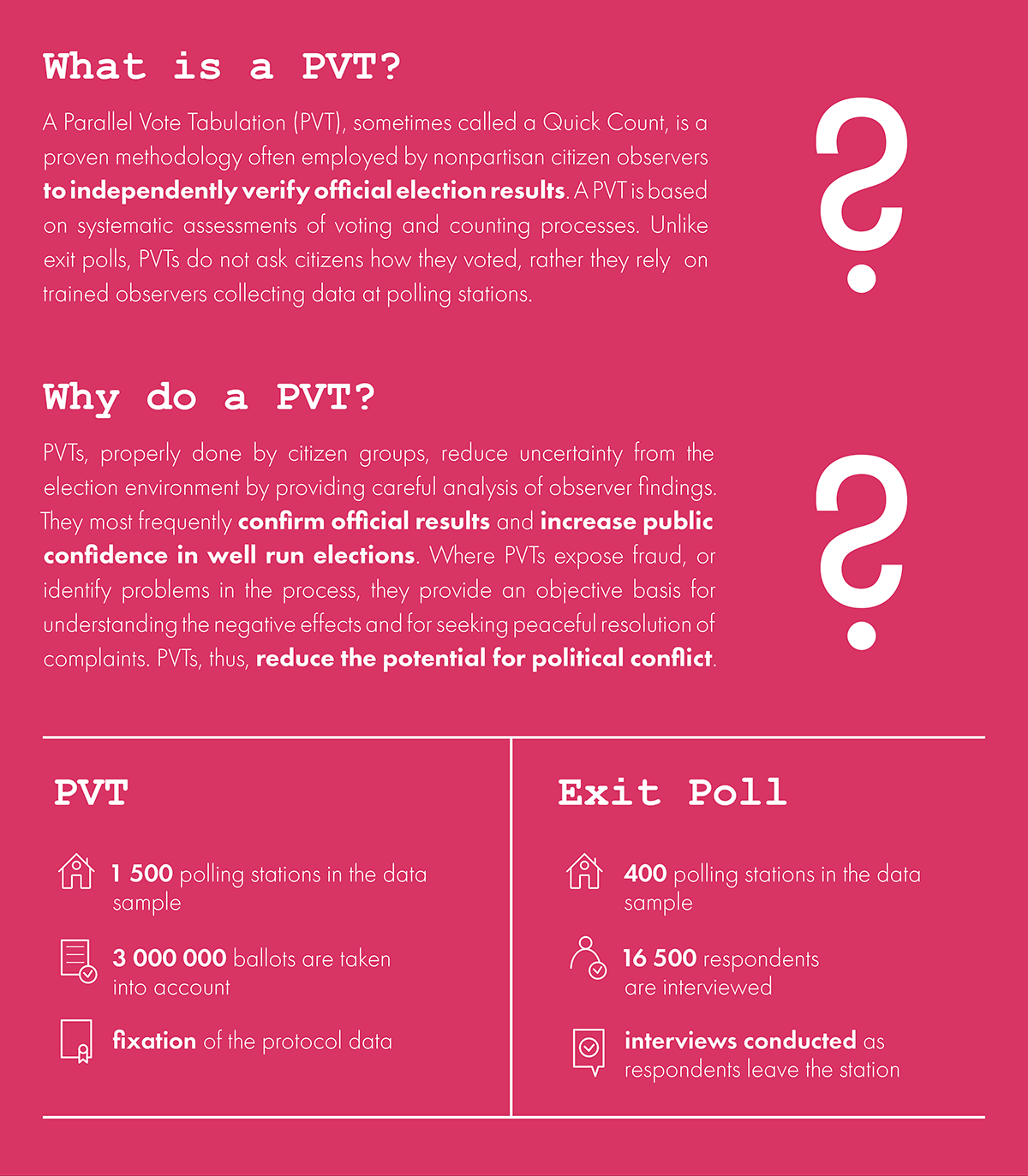
Why to conduct PVT?
PVTs can guarantee a prompt analysis of the election process based on primary data reported by observers. A PVT can confirm the official results and increase confidence in a well-run election. A PVT can also expose fraud, or identify problems in the process and assess the impact such problems may have on the outcome of the election. Thus, PVTs reduce the potential for political conflict.
What kind of information does the PVT provide?
PVTs produce reliable statistical data on which to base an assessment of the election process. Observers use a standardized form that allows them to evaluate the voting day and election results. PVT collects two types of information:
1. Information on the conduct of the process:
Observers use a standardized form that allows them to evaluate the integrity of the opening, voting and counting processes.
PVT allows to determine whether a vote count accurately reflects election outcomes and realize observation of a voting process during the day to detect any significant irregularities.
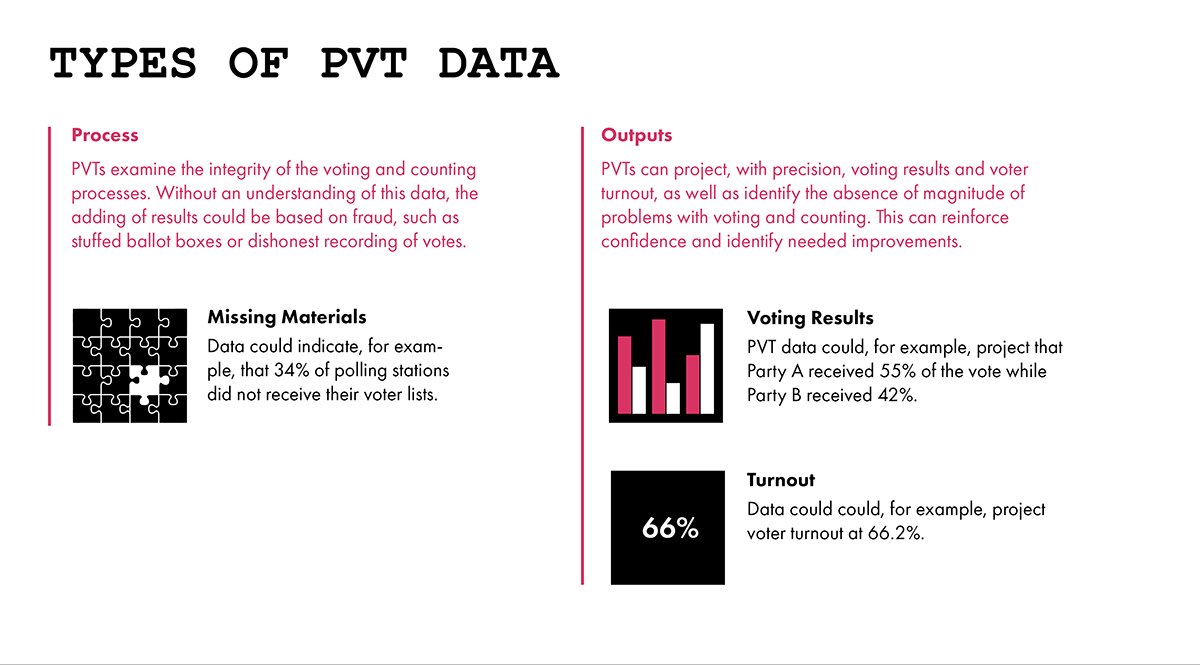
2. Official election results for the proportional race, as reflected in the PEC protocols:
- These data are examined only after the information on the conduct has demonstrated that the voting and counting processes went well.
- PVT can project the results of proportional component of elections and voter turnout with a high level of precision (i.e., low margins of error).
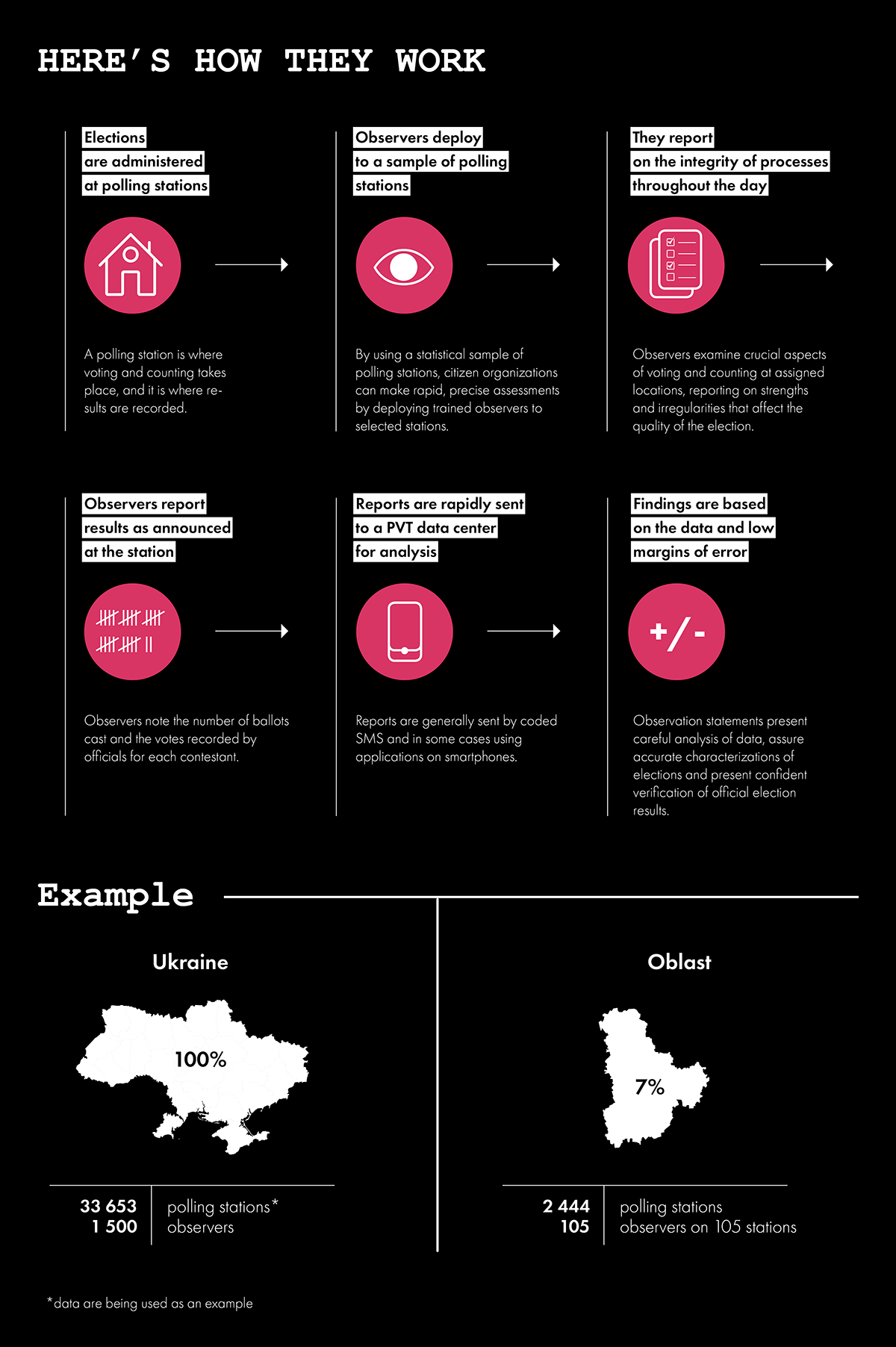
How accurate are PVT results?
During the presidential election in May 2014, a total of 861,148 Ukrainians cast their ballots at 1,500 sampled PVT polling stations monitored by the PVT. The margin of error for Yulia Tymoshenko was +/-0.6 % and so, the range predicted by the PVT was 12.6 % to 13.8 %. The official result, announced by the CEC was within the range of PVT – 12.8 %. However, the largest sampling for exit polls conducted in the last election was 17,000 voters in 400 stations. Thus, any exit poll is less precise than a PVT.

What if fraud is committed at the level of DECs?
If the data from PECs is trustworthy, the general results are determined indirectly through a statistical analysis. If official results are beyond PVT results, they are put in question. By monitoring the full election day process at polling stations, OPORA's representatives watch the voting process. This allows OPORA to assess whether the official results accurately reflect the will of the people.
What is OPORA's experience in realization of PVT?
Civil Network OPORA is a non-governmental, non-partisan and financially independent nationwide network of public activists that was formed in 2006. OPORA used PVT for both rounds of 2010 presidential election, 2012 parliamentary elections, 2013 repeated parliamentary elections, and this year's early presidential election.
Examples of successful OPORA's data
2012
Regular parliamentary elections
OPORA's sampling included 1,000 polling stations. It was a random representative sampling at oblast level, and gave a precise projection of voting results only for party lists.

2014
Early Presidential Election in Ukraine
On 25 May 2014, OPORA organized the parallel vote tabulation, based on representative and statistically-based sampling. The sampling included 1,500 polls, and the margin of error is not higher than 2.9%.
OPORA's observers were accredited and specially trained. They were analyzing the election process from 7:15am and till the vote tabulation at polling stations ended. Every of them sent 9 reports to OPORA's call-center.
On the basis of reports from 1,347 of 1,404 PVT observers, OPORA received the following results of the parallel vote tabulation conducted during the Presidential election:
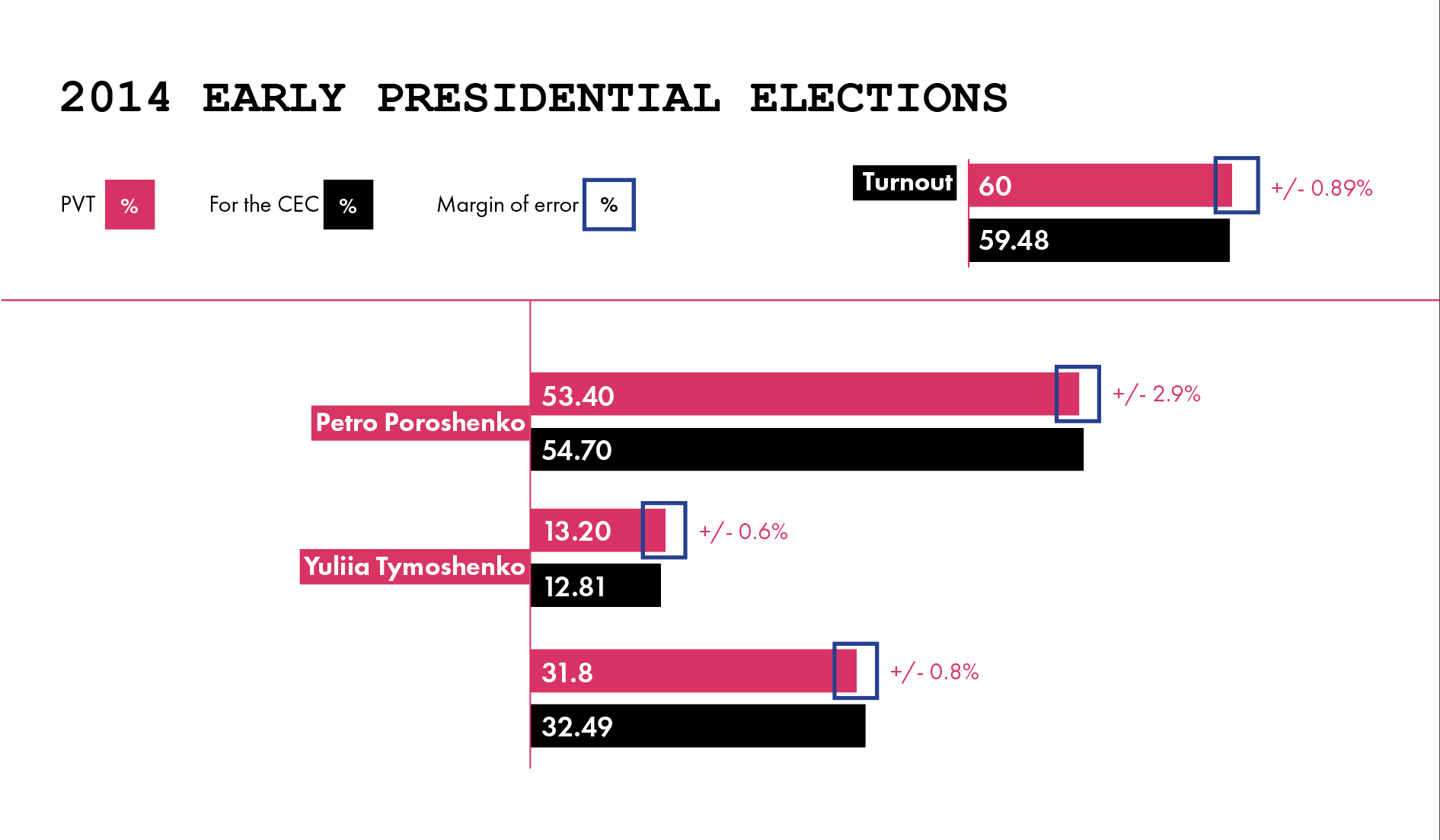
2014
Early Parliamentary Election
On 26 October 2014, OPORA deployed a network of 1,600 observers, selected through a representative sampling, to collect information and realize PVT. To monitor the election process during 2014 parliamentary elections, OPORA deployed 198 long-term observers to each district participating in the election.
OPORA was the only organization which had predicted the winner by party list in 2014 early parliamentary elections in Ukraine – the People's Front party (proved by the official data of the CEC), while the Petro Poroshenko Bloc was winning according to the results of all exit-polls. Besides that, only OPORA's PVT results predicted that the AUU Svoboda is not going to be represented in the newly-elected Parliament.
It should be mentioned that PVT results in party list election have fully coincided (within the margin of error expected by the PVT methodology) with the official results determined by the Central Election Commission announced on 10 November.
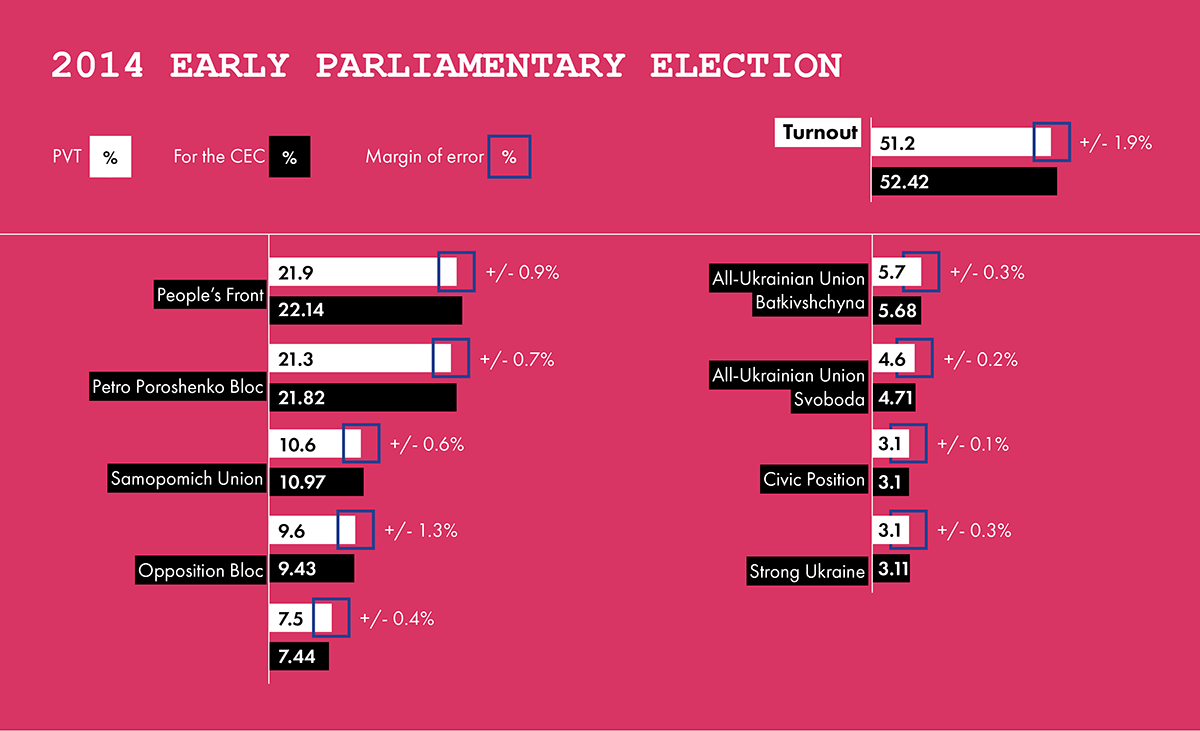
2019
Civil Network OPORA will conduct parallel vote tabulation (PVT) of election results for the eighth time, and will be the first to announce the results of regular election of the President of Ukraine on the very next day, 1 April 2019.
Countries where PVT was successfully organized
BEYOND PVTs
Systematic election observation, including through PVTs, increases citizen participation, enhances political and governmental accountability and provides a basis for advocacy. In addition, the skills that networks and organizations develop for PVTs can be employed outside elections.
NDI and PVTs
Since 1988, NDI has assisted citizen groups to perform over 200 PVTs in more than 52 countries. Based on 25 years of technical assistance to groups executing PVTs, NDI successfully employs peer-to-peer approaches, builds cross-border support networks and promotes PVT expertise. To learn more, please visit www.ndi.org/pvt
